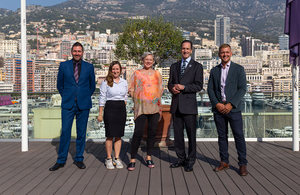Understanding the drivers, solutions and enablers within the shipping industry
The UK Hydrographic Office presents a white paper on the identified opportunities and challenges to the maritime industry, as the sector transforms through decarbonisation and digitalisation.

In Monaco for the sixth IHO Council meeting: (from left to right): James Harper IC-ENC General Manager, Helena Patton IHO Strategy Manager, Clare Lain Head of International Bodies and Technical Engagement, Rear Admiral Rhett Hatcher National Hydrographer & Director of Data Acquisition and Defence, and Jake Thacker Pugsley MA to Rear Admiral Rhett Hatcher
Representatives of 26 countries sitting on the International Hydrographic Organization (IHO) Council gathered in Monaco for the sixth IHO Council meeting, held from 18–20 October, to discuss the maritime sector’s transition to digital data services and the development and implementation of the new S-100 data standards.
The IHO’s S-100 data standards will greatly enhance our understanding of the ocean and the portrayal of the maritime environment. S-100 will provide a coherent framework for high-fidelity maritime data applications, which are fundamental to the shift from Electronic Navigational Charts (ENCs) to digital geo-information systems. Those systems will be capable of receiving and processing information on a wide range of applications, including imagery and gridded data, high-density bathymetry, dynamic tidal monitoring, and surface currents.
As requested by the IHO, the UK’s National Hydrographer, Rear Admiral Rhett Hatcher, presented a White Paper on behalf of the UK Hydrographic Office (UKHO) that sets out the key drivers influencing the shipping industry: decarbonisation and digitalisation.
Reducing shipping’s carbon emissions and increasing operational efficiency will require harnessing the latest innovation in navigational standards, such as the growing availability of high-speed internet at sea, integrated bridge systems, machine learning and artificial intelligence. Decarbonisation and digitalisation are shaping the future of maritime navigation, encouraging organisations to adapt and develop new solutions that meet the evolving needs of their customers.
The digitalisation of onboard systems, the rapid growth of the Internet of Things and the improvements in broadband communications increase the potential for smarter navigation, and for the number of connected solutions that the industry adopts. Decarbonisation has become a global imperative and a priority for governments, companies, and society at large which are now making commitments and increasing efforts to close the gap to net-zero emissions and create a sustainable maritime industry. A younger workforce at sea who are fully conversant with a digital world increasingly expect the sorts of connected services that they experience on land.
The UKHO’s White Paper sets out four themes for successfully meeting the evolving digital and sustainable needs of the mariner. Firstly, ‘resilience’ to create assured, secure, and reliable services for mariners today and tomorrow, followed by ‘sustainable’, ensuring we deliver solutions that enable efficiencies in route planning, analytics and voyage optimisation. The third is ‘data solutions’, which involves making the most of enhanced technology and connectivity between ship and shore to increase the speed at which we gather data on the marine environment. Lastly, ‘together’ is about collaborating with industry partners and users to research and innovate, learning how to unlock the potential of S-100 data services.
These four recommendations were evident throughout the Council 6 meeting. The Republic of Korea delivered the results of the S-100 Testbed, a project that it worked on with the United States of America. Representatives from the Asian nation explained the four main benefits of S-100: increased safety of navigation, improved efficiency, optimised load capacity for ships, and paving the way for autonomous shipping.
Additionally, the Republic of Korea confirmed it had established the National S-100 committee with Canada. The National S-100 committee will share the minutes of its meetings with interested parties, to enable collaboration across the industry and a greater understanding of future digital navigation opportunities.
Hydrography and its contribution to global initiatives, such as the Digital Twin of the Ocean, was also discussed. More than a simple model, the digital twin creates a virtual environment with near real-time data feeds, replicating the ocean environment to support the development and testing of new technology, and to model variations in the marine environment, such as those brought on by climate change or human activities. The Digital Twin of the Ocean could serve as a bridge between scientific knowledge and decision-making.
Following on from the White Paper, the UKHO will identify the lessons learned from the study and provide input through the relevant working groups and committees of the IHO. The UKHO also looks forward to continuing the conversation of digitalisation and decarbonisation in the maritime industry at the forthcoming IHO Assembly in Monaco in May 2023. It will continue to play a leading role in the implementation of S-100 data standards, particularly those approved at the International Maritime Organization’s Maritime Safety Committee meeting (MSC 106). The revised performance standards for Electronic Chart Display and Information Systems (ECDIS) to include the next technical generation of ENCs (S-101 ENC) will apply to ECDIS equipment installed on or after 1 January 2029.
The White Paper: Understanding the Drivers, Solutions and Enablers within the Shipping Industry